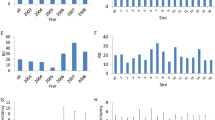Summary
We present a population dynamics model for annual plants subject to density dependent competition and a decline in mean individual fitness with inbreeding. An analysis of this model provides three distinct sets of parameter values that define the relative influence of inbreeding depression and density on population growth. First, a population with a relatively high finite rate of increase and a relatively small environmental carrying capacity can persist in spite of low levels of inbreeding depression. These types of population may occur during a bottleneck event that is caused by pure predation (or collecting) pressure rather than loss of habitat. Second, there can exist a minimum viable population size when the finite rate of increase is relatively low and the population is also affected by density: the growth or decline of the population will depend on the initial population size. Third, when the population is small enough to be simultaneously effected by density and by inbreeding depression, there can be no viable population.
Similar content being viewed by others
References
Allard, R. W., Jain, S. K. and Workman, P. L. (1968) The genetics of inbreeding populations.Adv. Genetics 14, 55–131.
Allee, W. C., Emerson, A. E., Park, O., Park, T. and Schmidt, K. P. (1949)Principles of Animal Ecology. Saunders, Philadelphia, USA.
Andrewartha, H. G. and Birch, L. C. (1954)The Distribution and Abundance of Animals. University of Chicago Press, Chicago, USA.
Antonovics, J. and Levin, D. A. (1980) The ecological and genetic consequences of density-dependent regulation in plants.Ann. Rev. Ecol. Syst. 11, 411–52.
Charlesworth, D. and Charlesworth, B. (1987) Inbreeding depression and its evolutionary consequences.Ann. Rev. Ecol. Syst. 18, 237–68.
Crow, J. F. and Kimura, M. (1970)An Introduction to Population Genetics Theory. Harper and Row, New York.
Grant, V. (1956) The influence of breeding habit on the outcome of natural hybridization in plants.Am. Nat. 90, 319–22.
Holsinger, K. E. and Roughgarden, J. (1985) A model for the dynamics of an annual plant population.Theor. Pop. Biol. 28, 288–313.
Lande, R. (1988) Genetics and demography in biological conservation.Science 241, 1455–60.
Lande, R. and Barrowclough, G. F. (1987) Effective population size, genetic variation, and their use in population management.Viable Populations for Conservation (M. E. Soule, ed.). Cambridge University Press, Cambridge, UK.
Lande, R. and Schemske, D. W. (1985) The evolution of self-fertilization and inbreeding depression in plants. I. Genetic models.Evolution 3, 24–40.
Leigh Jr, E. G. (1981) The average lifetime of a population in a varying environment.J. Theor. Biol. 90, 213–39.
Levin, D. A. (1990) The seed bank as a source of genetic novelty in plants.Am. Nat. 35, 563–72.
MacDonald, N. and Watkinson, A. R. (1981) Models of an annual plant population with a seedbank.J. Theor. Biol. 93, 643–53.
Morton, N. E., Crow, J. F. and Muller, H. J. (1956) An estimate of the mutational damage in man from data on consanguineous marriages.Proc. Natl Acad. Sci. USA 42, 855–63.
Pacala, S. W. (1986) Neighborhood models of plant population dynamics. IV: Single and multi-species models of annuals with dormant seed.Am. Nat. 128, 859–78.
Pacala, S. W. and Silander, J. A. (1985) Neighborhood models of plant population dynamics. I. Singlespecies models of annuals.Am. Nat. 125, 385–411.
Pimm, S. L. and Gilpin, M. E. (1989) Theoretical issues in conservation biology.Perspectives in Ecological Theory (J. Roughgarden, R. M. May and S. Levin, eds). Princeton University Press, Princeton, NJ, USA.
Schaffer, W. M. and Leigh, Jr. E. G. (1976) Prospects for a mathematical theory of plant population biology.Syst. Bot. 1, 209–32.
Schemske, D. W. and Lande, R. (1985) The evolution of self fertilization and inbreeding depression in plants. II. Empirical observations.Evolution 39, 41–52.
Schonewald-Cox, C. M., Chambers, S. M. MacBryde, B. and Thomas, L. (1983)Genetics and Conservation: A Reference for Managing Wild Animal and Plant Populations. Benjamin/Cummings, Menlo Park, CA.
Simberloff, D. (1988) The contribution of population and community biology to conservation science.Ann. Rev. Ecol. Syst. 19, 473–511.
Soule, M. E. (1980) Thresholds for survival: maintaining fitness and evolutionary potential.Conservation Biology: An Evolutionary—Ecological Perspective (M. E. Soule and B. A. Wilcox, eds). Sinauer, Sunderland, MA, USA.
Tilman, D. (1985) The resource-ratio hypothesis of plant succession.Am. Nat. 125, 827–52.
Venable, D. L. (1984) Using intraspecific variation in the study of the ecological significance and evolution of plant life-histories.Perspectives on Plant Population Ecology (R. Dirzo and J. Sarukhan, eds). Sinauer, Sunderland, MA, USA.
Watkinson, A. R. (1980) Density-dependence in single-species populations of plants.J. Theor. Biol. 83, 345–57.
Wright, S. (1921) Systems of mating.Genetics 87, 430–1.
Wright, S. (1969)Evolution and the Genetics of Populations. Vol. 2, The Theory of Gene Frequencies. University of Chicago Press, Chicago, USA.
Author information
Authors and Affiliations
Rights and permissions
About this article
Cite this article
Halley, J.M., Manasse, R.S. A population dynamics model for annual plants subject to inbreeding depression. Evol Ecol 7, 15–24 (1993). https://doi.org/10.1007/BF01237732
Issue Date:
DOI: https://doi.org/10.1007/BF01237732




